Week Four
This week I researched the international agreements governing the Mekong river.

The Mekong is world’s twelfth longest river, stretching over 2,700 miles long. It flows through China (where it is called the Lancang), Myanmar, Laos, Thailand, Cambodia and Vietnam. The river is known for its amazing biodiversity, and the people rely heavily on the resources it provides. To put the importance of the Mekong in context, a report from the Mekong River Commission stated, “In 2003, it was reported that some 40 million people or about two-thirds of the [Lower Mekong Basin] population were involved in the Mekong’s fishery at least part-time or seasonally. In Lao PDR, more than 70 per cent of rural households depend on fishing to varying degrees for subsistence livelihoods and additional cash income. In Cambodia, 40 per cent of the total population is dependent on the Tonle Sap Great Lake and its flood plains for their livelihoods.” While these figures may have decreased somewhat in the last decade, the importance of the Mekong, and the necessity for the continued availability of its fish, cannot be overstated.
The Mekong has another potentially massive resource: hydroelectric power. Laos wants to become the “battery of Southeast Asia” via hydroelectric dams, and hundreds of projects are planned all along the river. The trouble is that dams, especially on the proposed scale, would change the character of the Mekong. An impact assessment report prepared by HDR, a US based company, and DHI from Denmark summarized, “Mainstream hydropower development in the [Lower Mekong Basin] would cause irreparable and long-lasting damage to the floodplains and aquatic environment, resulting in significant reduction in the socio-economic status of millions of residents and creating social and economic burdens on local and regional economies.” As with all such reports, it is worth noting who ordered it. In this case, the report was at the behest of Vietnam, the state furthest downstream on the Mekong. Vietnam’s portion of the Mekong would suffer the effects of all the other projects. That is not to say the report is untrustworthy, just be aware of the source. Moreover, the estimated repercussions from planned dams along tributaries are equally as dire.
Broadly speaking, there are three possible international regimes that could monitor or limit these projects: the Mekong River Commission, the UN Watercourses Convention, and the Lancang-Mekong Cooperation Mechanism. These regimes greatly vary in effectiveness, age, scope, and formality. Once ODM has published the results of this research, I will post a link to that page and my opinion about these organizations and their efficacy.
After another lengthy international trip, I returned home Sunday, where I promptly fell ill. This week has seen me recover from one illness only to be struck by another, and all the while trying to overcome jet lag. Hopefully, over the next few days I will continue to improve.